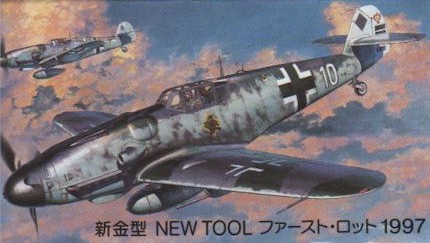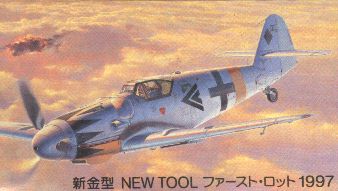 |
Shigeo's Superb Boxart for the 109G-6 kit |
| Catalogue No.: | JT-47 (109G-6) and JT-48 (109G-14) |
| Scale: | 1/48th |
| Media: | Plastic (see details in text) |
| Review Type: | In box |
| Rating: | Both Highly Recommended |
 |
Shigeo's Superb Boxart for the 109G-6 kit |
It's been a long time between 1/48 scale Hasegawa Bf109 variants, but these are the latest:
H a s e g a w a ' s 1 0 9 G - 6 I n T h e B o x |
Underneath the superb Shigeo boxart lie five sprues of medium grey, slightly brittle looking styrene. Two sprues, including the wing, are from the existing 109F/G series; three, including the fuselage, are new. Anyone familiar with Hasegawa Bfl09s will know exactly what to expect as far as surface detail - crisp and delicate (although personally I prefer the slightly chunkier approach to surface detailing demonstrated by Tamiya).
There is one sprue of clear parts. The canopy parts are from the earlier G series. A new section on the sprue adds the appropriate gunsight and armoured glass from the headrest.
Some of the sprues are labeled "Bf109G6/14". The inner surface of the new fuselage has a tiny hint of a raised line running along the inside of fuselage station 7. This was a clue that Hasegawa moulded an entire new fuselage for the tall-tail G-14 version instead of taking the easy way out and making the modeller do the surgery. For details of the differences between the kits, see the section describing the G-14 kit (below).
The sprue containing the horizontal stabilisers is labeled "Bf 1O9G/K".
There are a few small ejector pin marks on the gear doors, the tail wheel and the mainwheel hubs. Surprisingly, these are all new parts. Any other ejector marks are on the unseen inner surface of parts.
Cowl bulges are separate pieces. Options for both main styles of starboard bulges are provided (i.e. with and without the small scoop and compressor bulge). We are also given the option of using a tropical air filter.
The bulges on the upper wing to accommodate the wider wheels of the late G series are also separate pieces. You know the deal - you have to drill out the two locating holes in the upper wing and stick the bulge on the top. This is all very well and good - as long as you don't look at the model from underneath!
The interior looks a little sparse but is identical to the previous offerings except the instrument panel. A good range of detail sets for Bfl09s is available to improve this area; including Cooper Details, Hawkeye Designs and Eduard. (The best of all is the newly available "Hi-Tech" set from France. This set includes cockpit, bulged and flattened wheels, separate control surfaces and a full engine!)
The kit also features separate flaps and slats.
Ordnance is limited to a centreline drop tank and underwing MG151 20mm gun packs.
Dimensions look good. Fuselage length is spot-on, but the tail doesn't look 100% right. The angle at the front of the vertical tail may be a little shallow. Comparisons with scale drawings in Aero Detail No. 5 Bf lO9G seem to confirm this impression. Also, the nose seems to be angled slightly upward - only a degree or so. Wingspan is a couple of millimetres short according to Aero Detail. Don't get me wrong - I am not a member of the micrometer brigade. These are just observations. It still LOOKS like a BfIO9.
Two sets of markings are described in the instructions, but the decal sheet seems to have markings for three aircraft. The first is "White 10", a 109G6/R6 (with the MG151 gun packs) of J. Gr. 50. This aircraft is finished in greys 74/75/76 with an all-white tail and black-green spinner. The tail is adorned with an iron cross and a swag of victory markings; and the mid-fuselage has some interesting "waist art" (well, its not nose art).
The second scheme is not actually a G6 at all, but a Bf109G5/R6. However, the only external difference between the pressurised G5 and the non-pressurised G6 is the lack of the air scoops below the windshield of the G6 version. The truly anal-retentive amongst you (probably including me) will want to represent the small, round desiccant capsule wedged between the two layers on each glass panel.
This aircraft is "Yellow 13", with a squiggly 11 gruppe bar, from 11/JG27. It is also finished in the mid-war greys, and has a black and white spiral spinner, a white rudder and white fuselage band.
The mysterious third option, "White 7", may be an alternate machine from J. Gr 50. I will check it out.
H a s e g a w a ' s 1 0 9 G - 1 4 - S u m m a r y |
 Hasegawa's Bf 109G-14 is every bit as nice as the G-6 release. The main
differences are a new sprue for a G-14 fuselage featuring the tall tail (no chopping up
of fuselage required - hooray!), an alternative pressed gun trough for the forward
cowl (although the insert version issued with the G-6 is still included as an option -
G-14s were seen with either), and an Erla Haube clear vision canopy. The framed canopy is
also included as some G-14s still used this style. Two sets of markings are provided. One
is for a G-14 in winter camouflage flown by Erich Hartmann when he was Kommandeur of
I./JG53; and the second is an interesting blotchy aircraft with colourful Reich Defence
bands, attached to III./JG7.
Hasegawa's Bf 109G-14 is every bit as nice as the G-6 release. The main
differences are a new sprue for a G-14 fuselage featuring the tall tail (no chopping up
of fuselage required - hooray!), an alternative pressed gun trough for the forward
cowl (although the insert version issued with the G-6 is still included as an option -
G-14s were seen with either), and an Erla Haube clear vision canopy. The framed canopy is
also included as some G-14s still used this style. Two sets of markings are provided. One
is for a G-14 in winter camouflage flown by Erich Hartmann when he was Kommandeur of
I./JG53; and the second is an interesting blotchy aircraft with colourful Reich Defence
bands, attached to III./JG7.
C o n c l u s i o n |
Both of these models are predictably high quality offerings from Hasegawa. Although the recent Hobbycraft kits are very good, these new Hasegawa releases are probably the best 109Gs available today. So how long until Tamiya jumps on the bandwagon?
Back to HyperScale Main Page
Back to Reviews Page